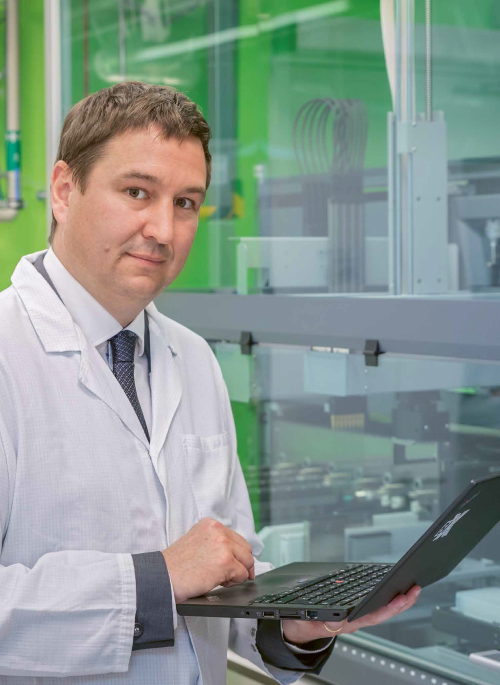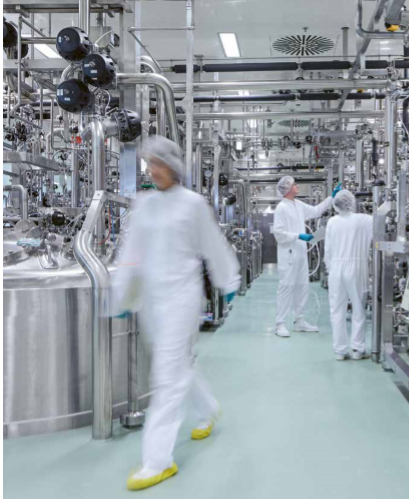S3.E9 像大型噴射機一樣複雜 As complex as a jumbo jet
價值故事屋 第三季全目錄
S3.E1. 新時代的來臨 | S3.E2. 數位化是一種工具,而不是最終結果 | S3.E3. 成為經典 | S3.E4. 時間的問題 | S3.E5. 豬圈聲音偵測器 |
S3.E6. 解讀隱藏的訊息 | S3.E7. 更好,更快,更進一步 | S3.E8. 未來的設施 | S3.E9. 像大型噴射機一樣複雜 | S3.E10. 每個人都在一個平台上
在以AI為基礎的生產工廠,生物分子通過電腦自學程式不斷增強,這正是在維也納的生物製藥專家與百靈佳殷格翰的BI X 數位團隊專家合作的目標。到目前為止,他們只處理全部過程中的其中一個步驟─發酵過程。如果該方法適用於整個流程,它將開啟全新的可能機會。Smart Process Design的其中一個負責人Jochen Gerlach博士解釋該計劃至今已取得的成就與其發展。

自2012年起Jochen Gerlach博士開始在百靈佳殷格翰工作並擔任在維也納生物製藥科學廠的負責人。新的大規模細胞培養生產預計在年開始營運,將創造包括基礎設施和500個新工作機會,總投資大約在7億歐元。百靈佳殷格翰從20世紀80年代開始一直是生物分子生產行業的先驅之一。
請問Gerlach先生,電腦能成為更好的研究人員嗎?
JOCHEN GERLACH(JG)笑了笑並說,不能,但它們可以幫助人們解讀數據。最好的方法是讓人和電腦一起研究。
這是您的Smart Process Design project背後的理念嗎?創造一個智慧助手來進行生產過程中所需的研究?
JG:你可以這麼說。在實驗室中開發生物製藥過程非常複雜、昂貴並且需要許多高度專業的知識和經驗。我們擁有一個軟體,其中包含完整生產過程的模型,它可以分析這個模型並進行預測,我們的目標是找到最好的生產過程。
生物製藥是否比傳統化學藥品生產更複雜?
JG:在生產過程中,我們使用對環境極其敏感的活體生物,此外,生物製藥的活性成分通常是相當高度複雜的生物分子。如果把一般的化學活性成分複雜度比喻成自行車,那生物抗體就相當於大型噴射機一樣,控制這兩方面的性質,是我們流程開發人員面臨的挑戰。
「在數據科學領域中已有重大進展,即使是大量數據也可以相對容易的被分析並發現其中的關連性。」
您是怎麼想出利用技術來解決這個問題?
2017年底在維也納,在生物製藥創新策略的範圍內,我們思考新的數位化技術如何能幫助我們延伸在技術和在市場上的領導地位,開發與主導生產過程的議題就此產生。我們擁有越來越多的數據,而且知道在數據科學領域中已經有了了重大進展,甚至可以相對容易的分析大量數據並發現其中的關連性。
所以你找上BI X.
JG:完全正確。畢竟,BI X是我們內部的數位化卓越中心。因此,我們向BI X的同事詢問是否可以借助他們的數據專業知識來幫助我們。我們在一個構思研討會上確認了這個想法,我們提出的計劃是建立和測試發酵步驟模型來驗證我們的假設。換句話說,是希望透過生物製藥開發中採用的數據分析來找到更好的生產流程。
在開發新的生產過程時,您的同事採用了什麼方法?
很多實驗具有系統化的變化參數,例如像是溫度,pH值或持久性。多年的經驗在這裡變得非常重要,可以在盡可能減少的實驗中收集最多的資訊。為此,我們利用一套軟體來分析數據,透過這種方式,我們達到了一個流程變體的階段,這階段中活性成分數量最高,即最佳。我們重複這些步驟,直到達到預定的目標。

您是如何想出進一步加強這些?
在生產規模上,我們反覆觀察生產過程,並發現仍有改進的空間。然而,我們目前用於分析數據的工具,並無法發現最佳的影響變數 。目前的軟體無法從中學習,當我做更多實驗時,它並沒有改善,它只分析一個事先預定的數據集。除此之外,它都只使用一種數據分析方法。這兩點是我們在Smart Process Design中特別點出的問題。
學習就是意味著要累積經驗,Smart Process Design現在也能夠做到嗎?
沒錯。我們的方法使用能夠學習新數據的模型:每當我們有了新數據時,該模型會進行改進並學習新的生產過程。我們沒有特定要求哪一部我們配置的機器需要學習技術,目前來說,我們使用人工神經網絡,它們特別適合在大量數據中進行檢測。數據量在這裡沒有意義,因為在開發過程中會積累更多的數據。
對於化學家來說,生物技術人員和工廠技術人員突然發現自己與BI X的數位專家一起工作,這會是一種文化衝擊嗎?
文化差異確實存在,我們首先必須確保我們說的是同一種語言並相互了解。我們BI X的同事必須熟悉生物技術,維也納的科學家必須學習一定程度的軟體開發。
在模型之後,你下一步會怎麼做?
在第一個階段結束前不久後,我們成功的在實驗中證明了我們的假設。事實上,Smart Process Design在我們發酵階段中發現了效率更高的影響變數。在下一階段,我們想要證明我們可以為幾個連續的過程階段建造模型。然後我們可以在某個時候,完成所有的生產過程,並著手思考過程階段之間所有相互依賴關係。
最終您將擁有一個從頭至最終產品的完整過程鏈模型。
沒錯!我們將更接近我們對生產工廠中套用模型的願景。在生產流程仍在運行的時候,我們將能夠同時在電腦中分析中斷對後續流程步驟的影響,以模型為基準的指示是合乎邏輯的下一步。我們可以在進一步生產中更改設置以阻止中斷。當管理問題被釐清時,我們可以預測性的引導我們的生產工廠。
在未來某個時間點,自學系統可能不再只是建議你應該做怎樣的決定。
是的,然後您將擁有由人工智慧所管理的生產線。這是一個非常長遠的願景。通過我們的Smart Process Design,你可以說我們跨出了AI工廠的第一步。
Biomolecules from an AI-driven factory, constantly enhanced by self-learning algorithms: this is the vision that biopharmaceutical specialists from Vienna are working on with data experts at Boehringer Ingelheim’s BI X digital incubator. So far, they have only been dealing with one step in the process – fermentation. If the approach works for the whole process chain, it will open up completely new possibilities. Dr Jochen Gerlach, project owner of Smart Process Design, explains what the initiative has achieved to date – and where the journey is going.
Mr Gerlach, do computers make better researchers?
JOCHEN GERLACH (JG) (laughs) No. But they help people to interpret data. The best approach is for people and computers to research together.
Is that the idea behind your Smart Process Design project? To create an intelligent assistant for conducting research into production processes?
JG You could say that. The development of biopharmaceutical production processes in the laboratory is very complex, expensive and demands a high degree of knowledge and experience. We have a software solution in mind that contains a model of the complete production process. It could then a nalyse this model and make predictions. Our goal is to discover the optimal production process.
Is the production of biopharmaceuticals more complex than the conventional, purely chemical manufacture of medicines?
JG In production we use living organisms that react extremely sensitively to their environment. In addition, biopharmaceutical active ingredients are as a rule highly complex biomolecules. If a standard chemical active ingredient has as complex a structure as a bicycle, then an antibody is equivalent to a jumbo jet. Controlling these two aspects is the challenge for our process developers.
“Major advances have been made in the field of data science. Even large volumes of data can be analysed relatively easily to identify correlations.”
How did you come up with the idea of looking for a technical solution to this issue?
JG At the end of 2017, within the framework of the innovation strategy of biopharmaceuticals in Vienna, we considered how new, digital possibilities could help us to extend our technological and market leadership. The topic of developing and steering production processes crystallised from this. We have everincreasing data at our disposal, and we knew that major advances have since been made in the field of data science. Even large volumes of data can be analysed relatively easily to identify correlations.
So you turned to BI X.
JG Exactly. After all, BI X is our internal centre of excellence for digitalisation. So we asked our colleagues at BI X whether they could use their data expertise to help us. We refined the idea at an ideation workshop. The plan we came up with was to build and test a prototype for a fermentation step in order to test our hypothesis. That is to say, we hoped to find better production processes if we employed novel data analysis in our biopharmaceutical process development.
What approach have your colleagues taken so far when developing new production processes?
JG In many experiments, they have systematically varied parameters, like temperature, pH value or duration. Many years of experience are of special significance here. It involves collecting as much information as possible in as few experiments as possible. For this, we already use software that subsequently analyses the data. In this way, we arrive at a process variant in which the active ingredient volume is the highest, that is, optimal. We repeat this until we have achieved the predetermined target.
How did you come up with the idea of further enhancing all of this?
JG We have repeatedly observed at production scale that there is still potential for improvement in our production processes. Evidently, the tool we at present use for analysing development data is not capable of discovering the best process variant. The current software cannot learn. It does not improve when I do more experiments, but rather it only ever analyses the one predefined dataset. Furthermore, it only ever uses a single method of data analysis. These are the two things that we have addressed through Smart Process Design.
Learning means gathering experience: should Smart Process Design also be able to do that now?
JG Precisely. Our approach uses the socalled process mo dels that are capable of learning with new data. Every time we generate new data, the model improves and learns new aspects of the production process. We are completely free here as to which machine learning technologies we deploy. Currently, for example, we use neural nets. They are particularly well suited to detecting patterns in large volumes of data. The volume of data is of no significance here. That is particularly important as ever larger amounts of data accumulate in development.
Was it a culture shock, as chemists, biotechnicians and plant technicians, to suddenly find yourself working alongside the digital experts from BI X?
JG (laughs) It’s true that there were cultural differences. We had to ensure first that we spoke the same language and understood each other. Our colleagues at BI X had to familiarise themselves with biotechnology, and the scientists here in Vienna had to learn a certain amount about software development.
What will come after the prototype? What is the next step?
JG Shortly before the end of the first project phase, we succeeded in proving our hypothesis in an experiment. Smart Process Design has in fact identified a process variant for our fermen tation with significantly higher efficiency. In the next stage, we want to demonstrate that it is also possible to create models for several successive process stages. Then we could at some time model complete production processes and take into account all interdependencies between the process stages.
You would have a model that describes the entire process chain up to the purified end product.
JG Correct. Then we will have come a big step closer to our vision of employing process models in our production plants. We would be in a position to analyse what influence disruptions have on the subsequent process steps – in the computer, while the production process is still running. Modelbased instructions are the logical next step. We could change settings in further production in order to offset disruption. When the regulatory issues are clarified, we can steer our production plants predictively.
At some point in time, the self-learning system will perhaps no longer just suggest what you should change, but rather will decide itself.
JG Yes, and you would then have production that is managed by artificial intelligence. That is a very longterm vision. You could say that, with our Smart Process Design, we have taken a first small step on the path towards an AI factory.

